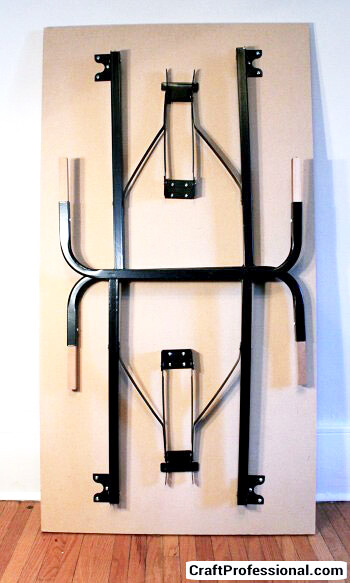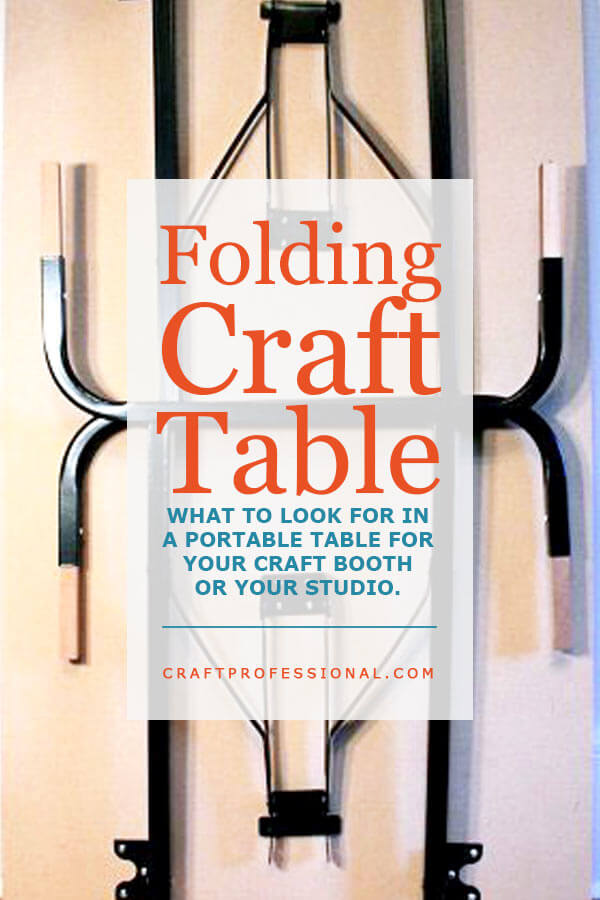Folding Craft Table Buying Guide
If you are in the market for a folding craft table, first determine whether you are going to use it for your studio or your booth or both, then take these 6 considerations into account to ensure your table meets your needs.
How do you intend to use your portable table?
- Will you be using it to provide work space in your studio?
- Do you want to use your table as part of your craft booth display at shows?
- Or, are you hoping your table will do double duty and work in your craft room and your booth?
If You Will Be Using Your Folding Craft Table in Your Studio, Consider the Following
1. Height of the Table
Ensure the table is an appropriate height for working on your projects and won't cause you to bend in uncomfortable positions.
If necessary, you may be able to adjust the height simply by adding PVC pipe or wooden shims to the legs to raise the height of the table to something that is more appropriate for your needs.
2. Size of the Work Surface

The amount of space you need depends on the type of projects you will be working on.
To determine the size of the table that will suit your needs, spread out your tools and materials in the way you would ideally like to work and measure the amount of space you require to work comfortably.
Be sure to take into consideration how much space you have in your workspace. Measure your available space, don't rely on guesses.
Unfortunately, I have made this costly furniture buying mistake.
When you look at a portable table in a big store, it may seem small because you're seeing it in a very large room, but when you get it home, if you haven't measured carefully, you may discover your table is much larger than you realized.Save yourself from the mistake of buying the wrong table size and measure carefully.
Related: How I made my own custom tables (and you can too).
I earn a commission for purchases made through links on this page.
To learn more, please see my disclosure.
3. Type of Work Surface
What is the table top made of?
- Will it withstand exposure to the raw materials and techniques you use?
- Is the work surface textured? Will that affect your ability to use the surface for your crafts?
- Does the table have a seam to allow the table to fold? Will that affect the usefulness of the work surface?
Consider how any of these factors may impact your ability to work effectively and comfortably on this work surface.
If You Will Be Using Your Folding Craft Table as Part of Your Display, Consider the Following
4. Size of the Table
Is the table large enough to provide ample display space yet small enough to fit into a 10x10 craft booth space?
Does the size of the table allow you to change the configuration of your booth display to fit different locations?
Check and consider the width as well as the length of your table because wider tables generally waste valuable space in a 10x10 booth.
You typically don't want items displayed so far back that customers can't reach them, so, unless you sell large items, if your table is more than about 24 inches wide, the back edge of the table top can become wasted space.
On top of that, you are often limited to a 10 by 10 display space at shows, so even an extra few inches of width in your adjustable tables can steal a lot of space and make your booth less inviting to customers.
5. Portability
- When the table is folded up, will it fit into the vehicle you intend to drive to shows?
- Is your table durable and easy to fold and unfold?
- Can you fold and unfold the table(s) yourself (helpful if you're doing any craft shows without an assistant)?
- Is it light enough that you can easily carry it from your booth to your vehicle by yourself if necessary?
6. Height

Standard table height (about 30 inches) is generally not ideal for displays.
Most displays will benefit from raising the table about 3-6 inches from standard table height. A few portable craft tables do have adjustable height legs, which makes it easy to raise up your tables to a better height.
If the tables you buy do not have adjustable legs, You can raise the height by cutting PVC pipes a few inches longer than the table legs and placing the legs inside of the pipes to raise the height of the table, or by inserting shims into the legs if they are hollow.
If your table is not high enough, check the design of the table's legs to ensure you can create a way to raise the height.
If you are using your folding craft table for displays at shows and as a work surface in your studio, consider the height required for both purposes.
If you need a different height for work and displays, raise your table with a less permanent solution (PVC pipes which fit over the legs can be easily removed, shims generally cannot) so you'll have the flexibility you need.


New! Comments
Have your say about what you just read! Leave me a comment in the box below.